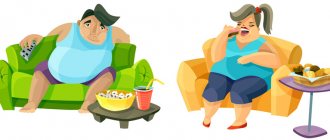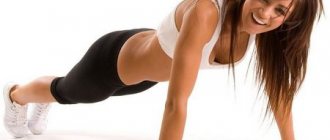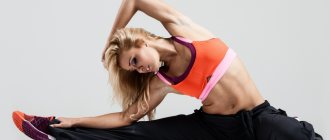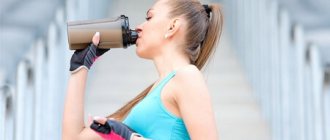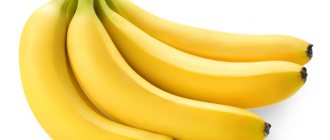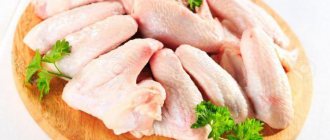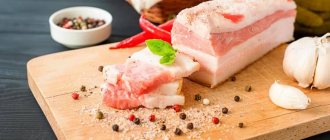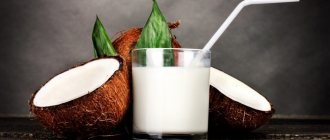2054
Squats can be called the most versatile exercise. With their help, you can pump up your abs, tighten your buttocks and thighs, and tone your body. This exercise, familiar to us from childhood, helps in the fight against extra pounds. It is enough just to do this simple exercise a few times a week, and the result will not take long to arrive.
However, both beginners and those who have been practicing for a long time are concerned about the question of how many calories squats help burn. In this article you can get the answer to this question and get acquainted with all the advantages of such an exercise.
How do squats burn calories?
Standard squats are a basic exercise that can be performed anywhere, even at work during a break. With its help you burn calories and get many additional effects:
- Squats work your calves, quads, hamstrings, and ankles. The complex work of all these muscles starts the process of burning calories.
- Under load, the buttocks are tightened - they become more elastic and cellulite goes away.
- When squatting, even the abdominal muscles work (they help maintain balance), so you additionally pump up your abs.
The work of many muscle groups and individual fibers makes squats a good fat-burning exercise, especially if you use a barbell or other weights.
Advice from experienced trainers
Trainers can advise on how to effectively and correctly perform this or that type of exercise. According to the recommendations of sports mentors, first of all, the calorie content of a person’s usual diet should be calculated. Next, it is adjusted in accordance with the person’s height and weight, after which an individual set of exercises is prescribed. When performing squats, it is extremely important not to “move” your knees forward, otherwise the entire load will be transferred to the knee joint, which can have a negative impact on the condition of the joints.
A competent approach to performing squats and alternating different types of this exercise strengthens the muscles and tone them, eliminating weakness and sagging.
https://youtu.be/6zDtHUsAqvM
https://youtu.be/PtbQUuvycqQ
How many calories does it burn?
One of the popular questions from people losing weight is: how many calories do squats burn? It is impossible to accurately indicate a specific indicator, since it depends on a number of factors, including:
- human body weight;
- weight of burdens;
- work intensity;
- duration of rest;
- number of repetitions.
The more difficult the conditions, the higher the calorie expenditure. Naturally, a squat with a barbell is more effective in this regard than regular squats without weight.
To give you something to start from, here are some approximate data. A person weighing 60 kg, squats 50 times in a few minutes, burns about 25 kcal. If you do 100 squats, you will burn 45-50 kcal. People with greater body weight will have to expend more energy.
What are the benefits of squats for the body?
Almost no workout is complete without some form of squats. The number of calories burned during this exercise is calculated based on the type and pace of squats, their number and number of repetitions.
Squats are good because they perfectly combine aerobic and strength training. After all, the exercise is performed in stages.
First you need to tighten your gluteal and abdominal muscles. Active burning of fat occurs due to the fact that it is the body that uses it for energy.
How to improve efficiency?
You understand how many calories one, ten or one hundred squats burn, but now we’ll tell you a few tricks that will help raise efficiency to a new level:
- Physical activity should be cyclical. This means that you strain yourself by squatting for 5-7 minutes, and then you rest for a minute and go to the next circle.
- Squats without a barbell should be quite intense. A high pace will help keep your heart rate in the desired range - this is important when burning fat.
- Try to exercise for at least 30 minutes (this includes 10 minutes of warm-up and stretching).
- Do not exceed the load on the heart and try to work in the pulse zone of 120-160 beats per minute.
- If you're doing barbell or dumbbell squats, choose a weight that allows you to do more than 15 reps.
- Train at least 3-4 times a week.
How to squat correctly to burn more calories?
Despite the fact that the calorie consumption during squats is quite large, it is still better to supplement them with other exercises, as well as by adjusting the diet. By creating a calorie deficit in your diet, and at the same time burning them through squats, you can lose weight faster.
If your level of physical fitness is beginner, it will be enough to do no more than 50 squats about three times a week with an interval of one day. You can break the exercises into several approaches. After a week or two, you can increase the number of squats to 100. 100 squats, which you can roughly determine how many calories are burned, is a more serious level of load.
The first results can be noticeable after a couple of weeks . Your body will become more toned and elastic, and your endurance will increase. A little later, you can switch to weighted squats, which will burn even more calories.
In many ways, the answer to the question of how many calories are burned when doing squats 20 times or another number depends on the execution technique. Different variations of squats make it possible to work different muscle groups to different degrees. The correct technique for performing exercises is also important - this will help improve not only your figure, but also your health. If you make mistakes in execution, especially with additional weights, you risk injury.
In almost any variation of squats, it is important to keep your back straight and squat until parallel to the floor or even a third. Be sure to limit the amplitude if you are overweight and at risk of knee injury. While performing the exercise, do not lift your slippers off the floor. It is also important to maintain the correct position of your arms and legs.
Squats, which you already know how many calories are burned, can be compared in terms of energy consumption with jogging at an average pace. They are a good way to get rid of excess weight, plus you can squat anytime and anywhere, which has also made this exercise extremely popular.
If you are overweight, your first priority is to get rid of it. Therefore, it is important not to limit yourself to squats, but also to include regular cardio exercises and exercises that work other muscle groups in your program.
Is it possible to lose weight with squats?
How many calories are lost from squats is one part of the question, but the second is even more important: is it possible to lose weight with this exercise? Of course, it should be included in the training complex for weight loss. It is important to choose the optimal rhythm, load, number of repetitions and duration of training.
To help squats help you lose weight, spend 7-10 minutes warming up before exercise. And keep in mind that even with such an effective exercise, you will not be able to burn fat locally, that is, remove excess fat only in the thighs or buttocks. Separately, a squat will help you lose weight, but the process will be less effective compared to a full workout that includes all muscle groups.
Thus, you can do squats to lose weight and burn calories at home, but if you sign up for a gym, it’s better to start doing full exercise, supplementing squats with other exercises.
Types of squats
At the moment, there are more than 40 types of squats: with and without a barbell, with dumbbells and lunges. The following will present the best variations of one of the most popular sports exercises:
- classic squats - a person lowers himself as low as stretching and physical training allow him. The weight is distributed evenly between the toes and heel, the back is straight. The goal is to tighten all leg muscles;
- plie - socks to the sides. If a person has been involved in sports for a long time, has good stretching and coordination, then it is worth aligning the feet in one straight line. When performing this type of squat, do not lower your head, look only forward. The goal is elastic gluteal muscles, toning the inner thigh;
- deep squat and triple spring - classic squats, weighted by balancing (swinging) in the bottom position. At the lowest point, movements of the pelvis are made with an amplitude of 7–9 centimeters, after which a smooth rise is made. The goal is to give elasticity and strength to all leg muscles;
- squats with rotation - when returning to the lower position, a tilt is made to the area of the right foot, then the lift is made through the left foot. The squat should be deep, your back straight. The goal is to work out the inner thighs;
- squats with lifting the leg and moving it to the side - when lifting from the bottom position, the leg is moved to the side, legs alternate. The goal is to work out the muscles of the legs and abs;
- squat with the leg pulled back - lifting the leg from a standing position. The back should be straight; when the leg is abducted, the body should not move forward. The goal is to develop the back of the thigh, buttocks and abdominal muscles;
- kick plus sumo - a deep squat, which includes lifting the leg 45 degrees and rotating along the axis. It is undesirable to bend the leg while turning in a circle; the back should be straight. Target – inner and back thighs, gluteal muscles.
Additional Information. It must be remembered that when performing any type of squats, you should not make jerks or sudden movements. This can cause injuries and sprains. You need to squat smoothly and control your breathing.
When starting training, you should know how many calories are burned when squatting. It has been scientifically proven that in half an hour of exercise you can burn from 200 to 400 kcal. Squats with dumbbells and a barbell with the correct technique will help you burn more calories. The barbell can be placed on the trapezius muscles and squats slowly, taking deep exhalations. Using dumbbells you can also give your biceps a workout.
There are more than 40 types of squats
How many calories do you burn when squatting: 10, 20, 50 or 100 times?
Squats are one of the most popular and effective basic leg exercises. It has a beneficial effect not only on the target muscles, but also improves the tone of the entire body, speeds up metabolism, burns fat deposits and much more.
Therefore, the question often becomes: how many calories are burned when doing squats? After all, representatives of the fair sex often use this exercise not only to form attractive legs and buttocks, but also as an effective tool for losing weight.
Despite the relative simplicity of the exercise, basic exercise is beneficial for the whole body.
How many calories does squatting cost? Let's try to understand this issue in more detail. It’s worth noting right away that there are no clear numbers here, because a lot of things depend on the intensity, weight, technique, etc.
In this material we will try to establish how many kilocalories can be spent on average when performing exercises with and without weights, and how to correctly calculate calorie consumption for those who are interested in losing weight.
Before we figure out how many calories are burned when squats, let's consider all the advantages of this exercise.
Squats are a basic physiological movement that combine aerobic and strength training.
The squat is one of the most effective and energy-consuming exercises that actively burns a fairly large number of calories.
Squats have the following benefits:
- Effective gain of muscle mass. Helps strengthen and develop all leg muscles. At the same time, many muscles are involved in the movement, which allows you to accelerate the production of testosterone and ensure growth.
- Great for burning fat. Since more than half of the body is involved in the exercise, enough energy is required. Accordingly, this is one of the most energy-intensive exercises.
- Improves mobility. Strength and endurance in the lower extremities allows for better control of the body, and through regular training, it will be possible to withstand more load on the legs.
- Increased functionality. Ideal not only for those who go to the gym, but also for those who play other sports - running, cycling, swimming, etc.
- Differs in versatility. The exercise will benefit both beginners and experienced trainees. They can be done both in the gym and at home.
- Improves coordination. The exercise allows you to develop not only strength skills and build muscle mass, but also improve control over movements.
- Increases flexibility. Excellent for increasing the elasticity of leg muscles, which helps improve athletic achievements in other disciplines.
- Strengthens joints. With the correct technique, the knees and hip joints receive an even load, which increases their strength and endurance. It is important not to rush into increasing the weights on the barbell, but to do everything gradually.
- Great for training your abs. When performing the exercise, the abdominal muscles take part in the work. Regular squats help to pump up the abs, strengthening the muscles, which will be important for those who want elastic abs.
- Availability of variations. You can squat using various techniques, shifting the emphasis to the quadriceps or buttocks.
Let's return to the main question - how many kcal are burned during squats? Let's start with the fact that there is a process of losing and replacing calories:
- Calorie expenditure is the energy expenditure that a person expends during physical activity.
- Calorie replenishment is energy entering the body along with food.
- If more energy comes in than is expended, then this process is called calorie surplus , but if there is a lack of energy, it is a calorie deficit .
Special attention should be paid to the concepts of calorie and kilocalorie. Let's understand the correct use of terminology.
A calorie is a small unit of measurement, so it is correct to say kilocalorie. However, both nutritionists and ordinary people say calorie instead of kilocalorie. And this does not cause any misunderstandings.
Calorie consumption in squats depends on:
- pace of exercise;
- weight of the trainee;
- burdens and other factors.
As an example, let's take a person with a body weight of 60 kilograms who squats without using weights. By squatting at a moderate pace for 5 minutes, you can perform about 100 squats. In this case, the body will need to spend 40-45 calories. This number is an arithmetic average and may vary depending on body weight.
https://youtu.be/v7Ln3a4nCcA
The more a person weighs, the more calories are lost during squats. After all, the body requires more energy to carry out the effort.
Do you want to improve your figure and health, without harming your spine and joints? Get my free resources on smart fitness at the gym or at home and learn how to exercise the right way!
They are suitable for both beginners and advanced fitness fans.
Source: https://fitspine.ru/uprazhnenija/bazovye/skolko-tratitsja-kalorij-pri-prisedanii-10-20-50-ili-100-raz/
The benefits of squats for weight loss
The benefits of physical exercise are known to everyone. The lower body can be corrected through a variety of specific workouts, all of which include squats. Their benefit lies in the fact that they help to work out all the muscles of the legs.
Squats are only beneficial if they are performed correctly. If squats are performed incorrectly, there is a risk of injury and injury.
Squats are of great benefit if you want to lose weight. If they are performed with the proper intensity, squats burn a significant amount of calories - on average, from 25 to 285 per quarter of an hour. Therefore, these exercises are recommended for use by anyone who wants to lose excess weight.
Effective squats to burn calories
Effective squats for burning calories are performed as follows. You should stand straight with your feet shoulder-width apart. Your arms should be extended forward. A squat is performed with your arms extended forward, parallel to the floor. You should sit down to the level of the chair seat, or a few centimeters deeper. You cannot lift your feet off the floor. By straightening your legs you can return to the starting position. It is effective to perform three sets of fifteen repetitions.
In addition to squats, you can do leg swings to burn extra calories. In addition, these exercises strengthen the leg muscles well. They are performed at a slow pace; to perform them correctly, you should lean on the back of a chair or stand next to a wall. First, a dozen swings are performed in one direction, then in the other direction with different legs, using four approaches in different directions.
Benefits of Squats for Burning Calories and Your Figure
Squats help you gain strong and sculpted legs, as well as firm buttocks. This is quite obvious and attracts girls of all ages. Squats can be regular or supplemented with various loads on the back and legs, for example, a barbell or dumbbells. For young mothers, their baby can be a kind of weight, which can be taken in your arms or placed on your back.
If you are still wondering about how effective squats can be, we will present some very interesting arguments in their favor.
- Building muscle mass . Squats allow you to develop your calves, quadriceps, and hamstrings. The growth of muscle mass ensures accelerated production of growth hormone and testosterone.
- Burning fat . More muscle allows you to lose more fat. The increase in muscle mass that squats stimulate allows you to burn more fat. Accordingly, the more muscle you can build, the more calories you can burn during training.
- Functionality. Squats will bring a lot of benefits to both beginning athletes and professionals and will allow you to strengthen your muscles and musculature, and at the same time improve your figure.
- Maintaining mobility. By increasing endurance and strength in the lower extremities, squats can help maintain body mobility. In addition, squats allow you to develop muscles, which means that with regular training you will stop feeling pain in your legs and will be able to carry out long-term loads.
- Improved coordination. Squats allow you to develop strength skills and control movements. Squats with dumbbells, etc. are good for coordination.
- Increasing the achieved results . Squats used in combination with other exercises - abdominal exercises, etc. - will improve your achievements.
- Avoiding various injuries. By following the correct squatting technique and maintaining an even posture, you can force the muscles to work smoothly, gradually make weak muscles stronger, and therefore avoid various injuries.
- Development of the muscles of the central part of the body . In addition to the lower body, squats also use the muscles of the central part of the body, including the muscles related to the abdominal area. According to some reports, squats in the fight for elastic abs can be even more effective than crunches that many are accustomed to.
- Improvement of joint condition. The correct technique will strengthen your ankles, knees and hip joints. The attractive thing is that the load on these joints is distributed evenly.
- Practicality . You can do squats at home or in the fresh air, and you don’t have to set aside separate time for this. Squats can be combined with regular homework.
- Various variations of the exercise . Squats can be performed using various techniques, which will improve the buttocks or pump up the calves, etc. The position of the legs and their width relative to the shoulders play a lot in this.
- No additional costs. If to exercise in a fitness center you need to have not only free time, but also finances, then squats do not require any monetary expenditure.
- Flexibility . Squats develop flexibility.
Squats and calorie consumption
Undoubtedly, for each person the number indicating calories burned will be purely individual, since the greater the weight of the squat, the more energy the body requires to perform the exercise. Therefore, your calorie consumption will also be greater. For example, if you take into account a number like 30 squats. How many calories does the same 62 kg athlete burn if she performs that many repetitions? Simple calculations are carried out - 43 is divided by 100 and the result is 0.43, that is, the number of kilocalories spent on one squat. And if you multiply this figure by 30 repetitions, you get 12.9 kilocalories.
It should be said that significantly more calories will be spent if the athlete uses weights, since the energy expenditure will also increase.
Harm from squats
As you know, there is a downside to the coin, and squats can sometimes do more harm than good. How does this happen?
- During their execution, the main load falls on the knees - they suffer the most and then can manifest themselves with sharp pain.
- Improper execution technique can result in too much stress and even injury.
- Before performing squats, you need to warm up and stretch. If this is not done, then later, during exercise, you can damage the ligaments and tendons.
Look at the same topic: How to remove fat from the sides and waist in a short time: tips and exercises
Squats are contraindicated:
- People suffering from knee diseases;
- Those who are overweight;
- For those who have problems with the spine;
- People suffering from diseases of the cardiovascular system;
- Children: they should perform squats more carefully and strictly under adult supervision!
How to do squats correctly?
It would seem that doing squats is not difficult, however, like any other activity, this art requires compliance with certain rules and conditions.
- Squats should be performed with a straight, straight back and be as low as possible.
- In 4-5 minutes it is enough to do 15-20 squats. It is enough to do 4 such approaches per day.
- The workout should begin with a warm-up that involves several rotations and flexions of the ankles and knees.
- The starting position for a squat involves feet placed shoulder-width apart, with toes pointed in different directions. The heels should be firmly on the floor. When doing squats, you should never lift your heels off the floor.
- Whenever you squat, look straight ahead.
- Watch your back position. The back should remain flat and not rounded. The back, neck and head should always be in the same plane. Correct body position will prevent back pain.
- While your knees will form a right angle, meaning your thighs will be parallel to the floor, you don't need to go below this position. Otherwise, a high load will be placed on the knees and hip joints, which can cause pain.
- When squatting to the lowest possible point, be sure to stay there for 5 seconds. You also need to climb slowly.
- When squats, breathe through your nose evenly and deeply. When going up, you should exhale, and when going down, inhale.
- When performing the exercise, if you are not using dumbbells, extend your arms forward.
- To supplement exercises with dumbbells, you should give preference to slightly weighted models, for example, made of heavy plastic.
- If you feel tired, stop the exercise. Start with a small number of squats and gradually increase the number. Significant results from regular exercise can be obtained after a couple of months. The buttocks and thighs will become elastic. To speed up the effect, you should combine squats with other types of training. For example, a vacuum massage can be an addition. You should also eat less fatty foods.
- You can start with three sets of 10-20 squats at intervals of 10 minutes. At first, you can exercise three times a week. After a month of intense training, the break can be reduced to 5 minutes, and the maximum number of squats increased to 25. There is also a special technique aimed at 1000 squats per day, but no more than 10 squats in a row. Such an experiment should be carried out no earlier than 3 months after training.
The essence of squats
Squats are exercises that are aimed at increasing muscle mass and strength. Due to the fatigue that occurs after properly performed squats, a large number of calories are burned.
Squats work the muscles of the buttocks, legs and back. With these exercises you can not only pump up these muscles, but also get a beautiful relief.
If you want to lose weight and get luxurious shape, these exercises are irreplaceable.
But the effect of squats will be noticeable only if they are performed correctly. Many people make mistakes in exercise technique and later wonder why they don't work.
The algorithm for their implementation is as follows:
- Stand straight, place your feet slightly wider than your shoulders.
- Your back should be perfectly straight: to do this, lower your shoulders down and move them back. Try to maintain a straight posture throughout the entire exercise.
- You can stretch your arms forward with your palms pointing down, you can bend your elbows and press them to your body, you can put them behind your head or press them to your waist, or you can clasp them together and stretch them out in front of you - whatever is more convenient for you.
- We begin to perform a squat: move your hips back while bending your knees. Don't raise your shoulders and watch your posture!
- Also make sure that your legs are perfectly straight and motionless.
- Move your pelvis back (imagine that there is an invisible chair behind you that you want to sit on).
- You should lower your pelvis as low as possible - this way the effect of the exercise will be more noticeable.
- Return to the starting position and repeat everything again.
How many calories are burned when squatting? How many calories are burned by squats 50 times?
Exercises such as squats can reasonably be considered effective for losing weight.
During this exercise, not only calories are consumed, but the appearance of the body also improves, the gluteal and thigh muscles are worked out, the riding breeches area is tightened, and the skin becomes less flabby.
How many calories are burned when squatting? This is a question that is easy to answer; it is enough to know the person’s weight parameters and the pace at which he performs this training.
The effectiveness of squats in losing weight
The secret of squats is that the load during their execution is not only strength, but also aerobic, since the exercise has two stages:
- During the squat, the muscles of the legs, buttocks, abs, and back are tensed.
- When lifting, a force load occurs due to your own weight.
That is why, during squats, fats are burned quite rapidly, that is, oxygen is actively supplied to the muscle tissue, which, in general, contributes to the destruction of lipids. The body needs energy to work, and it takes it from these same fats.
Probably, everyone who has used squats as an exercise for losing weight has been concerned more than once with the question: “How many calories are burned when squatting?” We can say that their number directly depends on the weight of the squat and the pace at which he performs the exercise.
For example, an athlete weighing 62 kg will sit down about 100 times within five minutes, while spending approximately 43 calories, that is, kilocalories. Sometimes a kilocalorie is mistakenly called a calorie. As a rule, this does not cause any misunderstandings, since the calorie is too small a unit of measurement - a thousand times smaller than the kilocalorie.
Therefore, in any literature on dietetics the name “calorie” is more often used, implying kilocalories.
So, to make a calculation for an indicator of 50, you need to divide 43 kilocalories by two. The result will be a figure of 21.5, which will be the answer to the question of how many calories are burned in 50 squats.
Types of squats
Squats are suitable for both gym and home exercises. To do exercises and lose weight, it is not necessary to use special exercise equipment and devices; the load can also be your own body weight.
The most common and understandable type of squats is the classic one. They do not require special skills or large space. The load distribution depends on how deep the squat is. The placement of your feet also matters. For example, plie squats are the most effective for pumping up the buttocks, as are sumo squats.
How many calories are burned during squats, which are called partials? Presumably more than in the deep process.
This type of squats can be called cardio-strength, since they are performed at an intense pace and allow you to work those muscles that are not involved during a deep squat.
Therefore, to maximize your calorie expenditure, you need to do partial, high-repetition squats.
Squat technique
The calorie consumption during squats is also affected by the technique used to perform them.
- Before starting the main exercises, you need to do a light warm-up in the form of rotational movements of the knee and ankle joints. Warming up is especially important before squats with weights.
- You need to keep your back straight, slightly arching at the lower back.
- During the exercise, you should not lift your heels off the floor.
- When doing squats, you need to tense your abdominal muscles as much as possible.
- To avoid increased stress on your joints, you should avoid deep squats. The bottom of a proper squat is when your thighs are parallel to the floor and your knees form a 90° angle.
If we talk about plie or sumo squats, then foot placement and posture are no less important.
https://www.youtube.com/watch?v=sSj4CoTuGaA
When performing any type of exercise, you first need to think about technique and your own safety, and not about how many calories are burned during squats. 50 times is the most acceptable amount for beginner athletes.
And according to the above calculations, this is almost 22 kilocalories. If you do this training twice a day, you get 43 kilocalories, which is equivalent to 37 grams of potato chips, 175 grams of watermelon pulp or one average cup of cherries.
Squats and calorie consumption
Undoubtedly, for each person the number indicating calories burned will be purely individual, since the greater the weight of the squat, the more energy the body requires to perform the exercise. Therefore, your calorie consumption will also be greater.
For example, if you take into account a number like 30 squats. How many calories does the same 62 kg athlete burn if she performs that many repetitions? Simple calculations are carried out - 43 is divided by 100 and the result is 0.43, that is, the number of kilocalories spent on one squat.
And if you multiply this figure by 30 repetitions, you get 12.9 kilocalories.
It should be said that significantly more calories will be spent if the athlete uses weights, since the energy expenditure will also increase.
Squats with weights
Some ladies mistakenly believe that by using weights in squats, they will pump up their leg muscles and look like football players. Unfortunately, everything does not happen so quickly, even though it is in the leg muscles that fat is burned faster and more efficiently than anywhere else.
So, to make your legs and hips look slender and sculpted, and your buttocks toned and firm, you need to get rid of fat deposits in these places. And to do this, you should properly load your muscles and use special equipment in the gym or at home. Ideal equipment such as a barbell, dumbbells, weights and expanders. There are also special simulators.
Why are squats dangerous?
Naturally, the question of how many calories are burned when squatting is important, but it can be completely meaningless if there is a risk of injury during the exercise.
According to research conducted in the 1950s, squats were considered dangerous and were thought to cause knee strain.
Over time, this kind of stress can weaken the joint, lose stability and begin to hurt.
Based on these studies, the training program in the US Army has even changed, where some military units have completely abandoned this exercise.
After these events, squats had a bad reputation for quite a long time, and only in the late 80s the exercise received hope for revival. Completely new studies have been conducted.
To do this, they invited one hundred volunteers and checked the stability of their knee tendons. Over a period of time, some of the selected people squatted, while others did not. As a result, absolutely all participants in the experiment had their knee joints checked.
No difference was recorded, which means that the knees of the squats were not damaged.
Research was also carried out among weightlifters. Their knees were also in stable condition.
As a rule, the cause of injuries is improper exercise technique and working with heavy weights without preparation.
In addition to knee joints, squats can also be dangerous for your back. This mainly applies to exercise performed with weights. The spine may be damaged due to improper technique.
Fitness experts, as well as adherents of a healthy lifestyle, believe that squats help activate a process such as metabolism. In addition, they allow the body to burn excess weight even after training.
To have an attractive and toned figure, you should add squats to your training schedule. This is the best way to make your legs slender, your buttocks firm, and most importantly, it is an effective method of combating excess weight. The effectiveness of squats has been repeatedly proven by both professional athletes and ordinary people losing weight.
And if you add proper nutrition to well-chosen exercises, the question of how many calories are burned when squatting will not seem so significant.
Source: https://FB.ru/article/189634/skolko-sjigaetsya-kaloriy-pri-prisedanii-skolko-kaloriy-sjigaetsya-pri-prisedaniyah-raz
